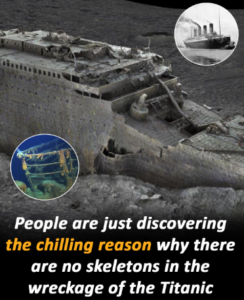The Mysterious Absence of Bodies in Titanic’s Wreckage
The Titanic disaster remains one of the most haunting maritime tragedies in history. When the luxury liner struck an iceberg on April 14, 1912, and sank into the Atlantic Ocean, over 1,500 people perished. However, despite numerous explorations of the wreck site since its discovery in 1985, one mystery persists—where are the bodies?
Given the sheer number of lives lost, one might expect to find human remains preserved in the deep ocean. Yet, divers and remotely operated vehicles (ROVs) exploring the wreckage have found no visible skeletal remains. This has led to speculation and scientific inquiry into what happened to the bodies that once drifted in the frigid Atlantic.
Natural Decomposition and Ocean Conditions
One of the most plausible explanations is that the ocean environment facilitated rapid decomposition. The Titanic lies nearly 12,500 feet below the surface, where water temperatures hover just above freezing. In such deep-sea conditions, scavenging organisms like deep-sea bacteria, crustaceans, and fish likely consumed soft tissues long ago.
Moreover, the ocean floor around the wreck is rich in metal-consuming bacteria that have slowly been breaking down the ship itself. These microorganisms likely contributed to the complete disintegration of human remains over the past century.
Acidic Seafloor and Skeletal Breakdown
Contrary to common belief, bones do not always persist in deep-sea environments. The Titanic wreck site consists of a seabed with high levels of acidity due to the reaction between seawater and iron from the shipwreck. Over time, this acidic environment may have dissolved human bones, much like how certain underwater caves erode limestone.
Additionally, the extreme pressure at such depths, exceeding 5,500 pounds per square inch, can influence decomposition in ways not fully understood. While other shipwrecks have revealed preserved human bones, those sites often exist in different oceanic conditions with less corrosive elements.
The Fate of the Victims
Many of the passengers who perished were not trapped inside the ship when it sank but instead were left floating in the open ocean. Historical accounts describe lifeboats encountering bodies drifting for days before rescue efforts ceased. Over time, the ocean currents likely carried them far from the wreck site. Some bodies were recovered by ships like the Mackay-Bennett, while others may have sunk to the seabed, where decomposition and scavengers erased their remains.
Evidence of Human Presence
Despite the absence of bodies, haunting reminders of the tragedy remain. Explorers have documented shoes, clothing, and personal belongings resting on the ocean floor, often in eerie arrangements suggesting where bodies once lay. Experts believe that leather, particularly from shoes, resists decay better than human remains, explaining why such artifacts persist while skeletons do not.
Conclusion
The mystery of the missing bodies is largely explained by the natural effects of time, oceanic conditions, and decomposition. While no human remains have been found, the Titanic wreck continues to serve as a solemn underwater memorial to those who lost their lives over a century ago.

